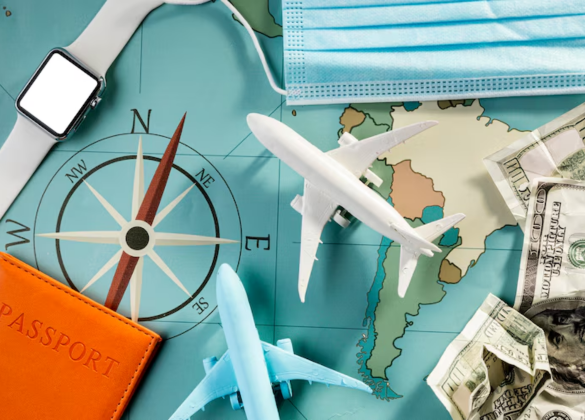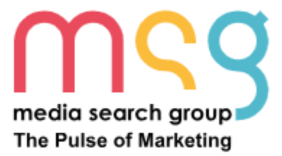Travel Insurance Link Building: Why and How to Build Quality Links
Search engines don’t care how trustworthy you think your brand is. They care about how trustworthy the internet thinks your brand is. In the eyes of Google, that trust is built through one thing: Link Building.
It’s the process of getting other credible, relevant websites such as top travel blogs, tourism boards, financial publishers, and even embassy sites to link back to your site.
At Media Search Group, we change that for you by helping you earn quality links that help improve your website’s domain authority. We provide specialized travel insurance link building services in New York City, Chicago, Miami, Los Angeles, Las Vegas, and all other cities in the United States and outside the U.S. as well. Here is why our travel insurance SEO agency is the best choice for you:
- Industry expertise of 13+ years
- Ethical, white hat link tactics
- Affordable link building packages
- Focus on E-E-A-T guidelines
- Transparent monthly link building reports
Our Travel Insurance SEO Services go beyond just link building — they’re designed to help you build lasting authority in a highly competitive space while meeting Google’s E-E-A-T guidelines
Ready to take back control with a travel insurance link building strategy?
Why Travel Insurance Link Building Is Essential?
Travel insurance isn’t just any niche. It sits right at the intersection of YMYL (Your Money Your Life) and seasonal urgency. That means Google watches your content and your links closely and you need to be working on content with E-E-A-T guidelines.
Here, E-E-A-T stands for:
E - ExperienceE - Expertise
A - Authoritativeness
T - Trustworthiness
If your backlink profile doesn’t reflect authority in the travel or financial space, you’re invisible. Most consumers don’t scroll past the first 3 results when looking for travel insurance. If your page is sitting on page 2 or lower, you might not get any click.
With travel insurance links, you're building the very signals Google uses to decide if you're worth ranking at all.
Why Travel Insurance Companies Can’t Ignore Backlinks Anymore?
You could offer better claims support, better coverage, better everything. But if someone types “best travel insurance for Europe” into Google, your competitor shows up first because they have more backlinks.
The Travel Insurance SERP Is Highly Competitive
Search “best travel insurance for seniors” or “travel insurance with medical coverage.” You’re not just competing with other travel insurers. You're going up against:
- Comparison giants like Squaremouth and InsureMyTrip
- Fintech publications with insane domain authority
- Travel blogs with loyal readers and newsletter subscribers
- News media with affiliate deals and aggressive SEO strategies
The average page-one result ranking for competitive travel insurance keywords has dozens, sometimes hundreds, of high-authority backlinks. If your site isn’t building those same trust signals, you’re permanently stuck in Google purgatory.
Backlinks with High Authority Help Create Trust
Backlinks are still the #1 indicator of authority, no matter what they claim about “content quality.” They want to rank pages that:
- Are endorsed by credible sources
- Are cited in expert articles
- Are referenced in educational or government content
Quality backlinks are how those endorsements happen. It’s all about the quality, relevance, and context of those links.
A single backlink from a respected travel site like Lonely Planet or Nomadic Matt could move your page higher than 10 random links from shady directories.
Google trusts those sites. When Google trusts them and they link to you, they start trusting you too.
The Link-to-Lead Connection in Travel Insurance
We’ve seen travel insurance providers land just one link from a top blog and generate hundreds of targeted visitors who are actively looking for policies. Even one quality link brings:
- Referral traffic from people already in travel mode
- Brand visibility from top-tier link placements
- Lead generation from content that converts
People trust the blogs they read. If your brand is mentioned in a “Top 5 Travel Insurance Companies” roundup, it feels like a recommendation. That is buying intent you can’t get with just ads.
How a Powerful Travel Insurance Backlink Profile Looks Like
You wouldn’t trust a no-name blog for financial advice, so why let Google think your brand hangs out with digital nobodies? If you're serious about ranking in the travel insurance game, your backlink profile isn’t just a nice to have. It’s your reputation, your authority, and your invitation to the first page of Google.
But here's what you must know: Google doesn’t just count links, it evaluates them, where they come from, how they were earned, and whether they belong in your industry.
Ideal Referring Domains for Travel Insurance Businesses
If you're in the travel insurance business, your links need to come from sources your customers and Google already trust. Here’s a hit list of powerful backlink sources for travel insurance agencies:
- High-authority travel blogs: Think Nomadic Matt, The Points Guy, or top-ranked regional travel bloggers. These sites attract real travelers, who could be your future policy buyers.
- Tourism boards & government travel sites: Though it might be very difficult, when a government tourism site links to your content, that’s Google gold.
- Financial publishers: Think NerdWallet, Investopedia, and Forbes Travel. Travel insurance is part of financial planning! Google knows this, and so should you.
- Online travel agencies (OTAs): Partner content or blog contributions on sites like Expedia, Trip.com, or Skyscanner give you credibility.
- Niche comparison sites: “Best travel insurance providers” listicles are highly trusted and conversion-heavy.
The Rule: If your audience reads it, and Google respects it, you want a link from it.
The SEO Metrics That Matter for Travel Insurance Link Building
Here’s what to measure (and why) when planning to acquire links for different websites:
- DA (Domain Authority) & DR (Domain Rating): These give you a rough sense of a site’s power. Aim for 30+ as a base. But don’t obsess. A DR 20 travel blog with passionate readers can outperform a DR 70 zombie site.
- Traffic relevance: Does this website attract traffic? If yes, what kinds of searchers? Nomads? Expats? Insurance shoppers? You want referral traffic that might actually buy.
- Topical alignment: The link you will be getting should make sense. A scuba diving blog linking to your guide on “Insurance for Tropical Island Travel”? Perfect. A plumber blog linking to your claims process? That’s suspicious.
- Link velocity: Google watches how fast you earn links. A slow, steady climb looks natural. A spike from 0 to 100 overnight? You might just set off alarms. If your link profile looks artificial, you will get penalized, not promoted.

Say Never Ever to Toxic Backlinks
If you’ve ever paid $99 for “1,000 backlinks in 2 days”, stop reading this and go disavow them now. Your backlink profile should look like your business card: Clean. Professional. Respected.
Even one bad link can harm your website and hurt your rankings. So, when building backlinks for travel insurance, you need to avoid:
- Spammy directories
- PBNs (private blog networks)
- Foreign gambling/casino/adult sites
- Sites with low-quality spun content
- Comment spam or forum profile links
Travel Insurance Link Building vs. Generic Insurance Link Building
Link building for life, auto, or home insurance, that’s often associated with financial publications, legal blogs, and evergreen content. But for travel insurance, link building should be fast-moving, seasonal, emotional, and geo-targeted.
- Seasonality: Search volumes spike before holidays and drop in off-seasons. Your link campaigns must ride the seasonal waves not fight them.
- Geo-targeting: “Travel insurance for UK travelers visiting the US” is wildly different from “travel insurance for Canadians visiting Bali.” Your content and backlinks need to reflect location-specific concerns.
- Trust: Your audience is often nervous, planning for the worst-case scenario. If they don’t feel safe on your site, they bounce. Links from high-trust travel sources reinforce confidence.
Why Travel Insurance Demands a Content-Driven, Trust-Based Link Building Strategy
Google doesn’t want insurance companies ranking just because they know SEO. It wants experts. With the rise of E-E-A-T (Experience, Expertise, Authoritativeness, Trustworthiness), you must earn your position. That means creating real, helpful, and shareable content that gets picked up naturally by:
- Travel bloggers writing about trip planning
- News outlets covering travel risks and regulations
- Forums and communities recommending reliable providers
This isn't a volume game anymore. This is about relevance, reputation, and real-world value.
Real Examples of Niche vs. Generic Link Profiles
Let’s compare two backlink strategies for travel insurance:
Company A (Generic)
- Got 50 backlinks from random directory sites and low-end financial blogs
- Anchor text is keyword-stuffed: “cheap travel insurance USA”
- Zero traffic increase in 6 months
Company B (Smart, Niche-Focused)
- Published a guide on “Travel Insurance for First-Time Backpackers in Southeast Asia”
- Earned links from 4 high-traffic travel blogs, 1 reputable tourism site, and 2 expat community forums
- Saw a 37% increase in organic traffic in 3 months
- Conversion rate on the guide page: 5.4%
See the difference? It’s not about more links. It’s about better ones.
Mistakes Travel Insurance Brands Make in Link Building
Some of the most common mistakes that travel insurance companies make during link building companies are:
Mistake #1: Most brands are chasing quantity over quality
When you flood your site with low-quality links, Google raises its eyebrows and sometimes, it closes the door entirely. Focus on these links for your travel insurance company instead:
- Links from topically relevant travel publications
- Placement on comparison pages travelers actually read
- Natural mentions inside helpful content, not sidebars or footers
Mistake #2: Misaligned Anchor Text
Anchor text like “Click here,” “More info” or worse “Cheap travel insurance best rates quick buy” are misaligned and don’t make your links trustworthy. Instead, your anchor text should:
- Reflect what the page is actually about
- Use partial-match phrases like “family travel insurance tips”
- Include your brand when possible: “Learn more from [ABC] Travel Insurance”
If your anchor profile looks like it was written by a robot in 2012, you need a reset.
Mistake #3: Short-Term Campaigns with No Focus on Long-Term Authority
Link building isn’t a weekend project and it’s not a 3-month experiment either. It’s a long-term investment in your domain’s equity. One that pays compound interest over time.
Ask yourself: do you want a spike in rankings that disappears by summer? Or do you want to be a brand that owns Page 1 for years? The travel insurance providers dominating Google today, they didn’t win with a “fast” strategy. They won with a consistent, trust-focused, and audience-first approach.
Proven Travel Insurance Link Building Tactics That Work
- Sponsored content which is done ethically with proper disclosures
- Travel insurance guides for specific trip types (backpacking, cruises, student travel, etc.)
- YouTube explainers or “what to pack for travel” listicles
Here are battle-tested link building tactics used by top travel insurance brands today:
1. Partner with Travel Influencers and Bloggers
Your future customers are already reading their blogs, watching their YouTube videos, and scrolling their Instagram stories. That makes influencers your shortcut to trust and traffic.
Collaborate on:

A mention from the right voice can send referral traffic and authority signals straight to your domain.
2. Publish Research-Based Travel Safety Reports
If you want backlinks from journalists, travel publications, .gov domains, and influential bloggers, don’t wait to be cited but become the source for their information. Publishing original research instantly elevates your authority. Think in terms of high-impact, timely topics that combine travel trends with insurance insights:
“Top 10 Safest Countries for American Travelers in [This Year]”“Post-COVID Insurance Claim Patterns by Destination”
“Where Travel Emergencies Happen Most, By Region”
Add depth with interactive maps, charts, and downloadable PDFs that reporters can cite. Most travel insurance companies skip original research because it takes time and money. That’s exactly why it works. It’s your unfair advantage.
3. Offer Guest Posts to Travel and Financial Sites
Guest posting still works but only if you treat it as a value exchange, not a link dump. Instead of offering generic travel tips that editors receive by the dozen, pitch highly relevant, experience-backed articles that align with the publication’s mission and audience.
For example, a travel site might love a guide titled “How to Choose Travel Insurance for an African Safari,” while a personal finance blog may prefer “Financial Planning for Students Taking a Gap Year Abroad”.
The content must be strong enough that even if it didn’t link to you, readers would find it worth bookmarking.
4. Build Relationships with Travel Agencies
Travel agencies and tour operators already serve the same audience you're targeting. Aligning with them strategically opens doors to powerful link and referral opportunities.
Start with a conversation, not a pitch. Co-create a resource or checklist for travelers, offer exclusive insurance discounts for their audience, or produce a joint blog or video series.
When you make it genuinely beneficial for them, including your link in booking sequences, blog content, or customer resource pages becomes easy and natural.
5. Create Country-Specific Landing Pages for Natural Local Links
Search engines and users both favor geo-specific content, and when you provide that, regional bloggers and local expat forums are far more likely to link to you.
Your travel insurance page, for instance, should include tips on local medical care, relevant embassy information, and common claim scenarios for that destination.
By becoming a location-specific resource, you’ll improve your local SEO and also attract inbound links from relevant, geo-targeted sources naturally.
6. Get Featured on Comparison Lists
The “Top 10 Travel Insurance Policies” lists that dominate Google’s Page 1 for high-intent searches aren’t just content pieces, they’re conversion machines. Being included in just one of these can mean sustained leads and traffic for years.
Getting featured takes more than asking. Identify list publishers who already rank well, then offer them something compelling: exclusive discounts for their audience, detailed product reviews, or affiliate partnerships.
7. Creating Content That Naturally Attracts Travel Links
A smart approach blends evergreen and seasonal content for travel insurance. Evergreen guides like “How to File a Travel Insurance Claim Abroad” or “What Travel Insurance Actually Covers” build long-term backlinks as others cite your authority. Seasonal content, on the other hand, helps generate interest during key events and holidays. Think “Insurance Tips for Summer Backpackers” or “Do You Need Insurance for the Paris Olympics?”
Together, they give your content calendar staying power and spikability, which helps you earn steady links year-round while capitalizing on moments of high demand.
8. Anchor Text Optimization for Travel Insurance SEO
In a YMYL space like travel insurance, how you use anchor text can either boost your credibility or trigger a penalty.
The best travel insurance SEO practice is to strike a balance between branded, partial-match, and exact-match anchors.
Google holds YMYL sites to higher trust standards. So, aim for contextually integrated links with diverse anchor profiles that flow within real, value-driven content.
Tools to Automate and Scale Travel Insurance Link Building
These SEO tools are your eyes and ears for research, analysis, and tracking link performance.
- Ahrefs: Find competitor backlinks, check referring domains, filter for travel or insurance relevance.
- Semrush: Spot link gaps, track keyword shifts, uncover outreach opportunities.
- BuzzStream: Manage outreach campaigns and communications in one clean dashboard.
Bonus: Use the Ahrefs Content Explorer to find broken or outdated pages in your niche to pitch replacements.
Broken Link Building Tools with Travel Insurance Filters
Broken link building still works if you’re targeting relevant pages.
Use:
- Check My Links (Chrome extension): Quick wins on travel blogs
- Screaming Frog SEO Spider: Crawl entire travel sites for 404s
- Ahrefs Site Explorer: Filter outbound broken links by topic (e.g., “travel safety”)
Then, offer your travel insurance guide or landing page as a replacement.
Strengthen Your Travel Insurance Website Authority with Strategic Link Building
Effective Link Building helps travel insurance companies earn trust and improve search rankings by acquiring high-quality backlinks from reputable sites. But for sustainable growth, link building should work alongside a complete SEO strategy. It all starts with precise Keyword Research to target the right terms that attract qualified leads. Expand your presence locally through Local SEO for Travel Insurance and ensure visibility in map packs with accurate GBP Optimization. Maintain a technically sound site using proven Technical SEO practices. Fuel your link acquisition efforts with engaging, informative content created through Content Marketing that’s tailored to your audience’s needs.
Travel Insurance Link Building FAQs
You can expect to see early signs of progress such as improved keyword rankings and increased organic traffic within 3 to 6 months. However, meaningful results, such as ranking for competitive travel insurance terms or seeing lead conversions, usually take 4 to 8 months.
Yes, a good agency will identify link opportunities tailored to travel insurance and monitor toxic links and protect your domain. You need to choose an agency that specializes in travel insurance SEO, travel insurance content marketing, and travel insurance-specific link building.
Yes, guest posting is still a very effective way to earn contextually relevant links from authoritative travel and other websites. You need to avoid spammy content mills and focus on high-quality, editorial-level travel and finance publications, unique, non-promotional content.
Yes, AI tools can help you draft first versions of blog content or guest posts, personalize outreach emails faster, and create templates for scalable prospecting. Always review content for accuracy, tone, and compliance in the travel insurance space where credibility matters.
Ready to build a link building campaign for your travel insurance agency?
Let’s build a high-ROI link strategy for your travel insurance brand!








